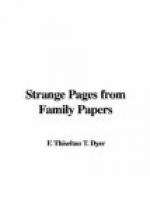What happened after their departure was never divulged, for no one “ever saw that wretched man again, either alive or dead.” That he had died some violent death was generally surmised, for a great stain of blood shaped like a human form was found on the floor of the room, and despite all efforts the mark could never be washed out. Ever since this inexplicable occurrence, the house has been haunted, and at midnight a ghostly troop of horses are occasionally heard, creating so much noise as to awaken even heavy sleepers.
And Aubrey in his “Miscellanies” tells how when the bust of Charles I., carved by Bernini, “was brought in a boat upon the Thames, a strange bird—the like whereof the bargemen had never seen—dropped a drop of blood, or blood-like, upon it, which left a stain not to be wiped off.” The strange story of this ill-fated bust is more minutely told by Dr. Zacharay Grey in a pamphlet on the character of Charles I.: “Vandyke having drawn the king in three different faces—a profile, three-quarters, and a full face—the picture was sent to Rome for Bernini to make a bust from it. Bernini was unaccountably dilatory in the work, and upon this being complained of, he said that he had set about it several times, but there was something so unfortunate in the features of the face that he was shocked every time that he examined it, and forced to leave off the work, and, if there was any stress to be laid on physiognomy, he was sure the person whom the picture represented was destined to a violent end.”
The bust was at last finished and sent to England. As soon as the ship that brought it arrived in the river, the king, who was very impatient to see the bust, ordered it to be carried immediately to Chelsea. It was conveyed thither, and placed upon a table in the garden, whither the king went with a train of nobility to inspect the bust. As they were viewing it, a hawk flew over their heads with a partridge in his claws, which he had wounded to death. Some of the partridge’s blood fell upon the neck of the bust, where it remained without being wiped off. This bust was placed over the door of the king’s closet at Whitehall and continued there till the palace was destroyed by fire.
FOOTNOTES:
[25] D’Israeli’s “Curiosities of Literature.”
[26] See Harland and Wilkinson’s “Lancashire Folklore,” 135-136.
[27] “Book of Days,” I., 235.
[28] This tradition is the basis of the drama called “The Yorkshire Tragedy,” and was adopted by Ainsworth in his “Romance of Rookwood.”
[29] 2nd Ser., p. 21.
[30] A curious legend is related by Roger de Hoveden, which shows the antiquity of the Wakefield mills. “In the year 1201, Eustace, Abbot of Flaye, came over into England, preaching the duty of extending the Sabbath from three o’clock p.m. on Saturday to sunrising on Monday morning, pleading the authority of an epistle written by Christ himself, and found on the altar of St. Simon at Golgotha. The people of Yorkshire treated the fanatic with contempt, and the miller of Wakefield persisted in grinding his corn after the hour of cessation, for which disobedience his corn was turned into blood, while the mill-wheel stood immovable against all the water of the Calder.”




